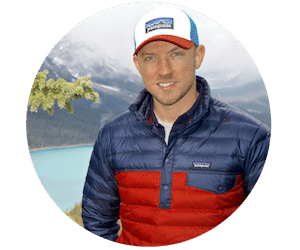
Our guide mentioned that Puerto Varas gets really busy in summer, but is pretty much shut down in the winter. Walking through town you get a good idea of its dependency on tourism – every other building is an adventure travel booking agent, pub or outdoors’ gear shop. We popped into the Patagonia shop for a peruse of what was on offer and picked up some bits and bobs for our trip. I love everything this brand stands for so was fun being in their shop based here in the heart of Patagonia.

Puerto Varas is a great location to base yourself in as you explore the surrounding areas. You’ll find an abundance of climbing, fishing, kayaking and canyoning opportunities in and around town. Our trip to Puerto Varas was to get up close and personal to the gem of the region – snowcapped Orsono Volcano. No matter where in town you are, you can see it and Calbuco Volcano towering in the distance. Although we didn’t stay here too long, we packed in a good bit and put a few more notches in our adventure belt.
We choose to focus our time exploring the Vicente Pérez Rosales National Park. Here is how we tackled the park in a day.
ORSONO VOLCANO
Our first port of call in the Vicente Pérez Rosales National Park was the Orsono Ski Center. Nestled at about 1,240m (3,937ft) on the conical, snow-capped Orsono Volcano, the ski center offers you great views of Llanquihue Lake and the Calbuco Volcano. Of course this is only true if it is a clear day. Was it for us? Of course not, but that’s the luck of the draw. There is a ski lift that takes you here if the weather permits, but we chose to drive directly to the parking lot. The lift can take you further up the Volcano to Station Primavera at 1,450m (4,757ft) or Station Glaciar, which sits at 1,750m (5,741ft).

From the ski center we hiked the hour long return trip to the Red Crater, one of the 8 craters located on Orsono. The initial ascent was steep but a great workout. The clouds never really cleared for our group so we didn’t see the panoramas this place is known for. If we had more time I suspect we would have chosen to make the hike when the weather was better.


After our hike we warmed up by the fire at the Ski Center and enjoyed a hot chocolate with whiskey. I made a new (puppy) friend who seemed to follow me around the center, which was cute. After a few cuddles we hopped back in the car and made our way to our next pit stop.

EL SOLITARIO
After driving down the Volcano we hopped out at the El Solitario Footpath for a 6km hike through the Vicente Pérez Rosales Park. We initially wanted to mountain bike through the area but the recent volcanic eruption meant that the trails were lined with a fair bit of ash and far too difficult to mountain bike on. The path itself is an easy hike that takes you through the lush forest and offers different perspectives of the Santo Domingo Mountain Range and surrounding volcanoes. The weather cleared up for us a bit which meant we were finally able to see Orsono in all it’s glory.



TODOS LOS SANTOS LAKE
Having worked up an appetite, we got picked up at the end of the El Solitario trail and headed out to the beautiful Todos Los Santos Lake for lunch. Now this was no ordinary lunch. At the lake we had a local fisherman take us out on the gorgeous Todos Los Santos before banking on the shores at his house for a home cooked meal. Fishing in Patagonia is deeply routed in the essence of the region as both big business and big sport. While we didn’t partake in the actual fishing, we were able to enjoy the fruits of our fisherman’s labour with his catch of the day – brown trout – yum.


A short drive from Puerto Varas, the lake itself is stunning. From the boat you get a view of the Andes, including not only Osorno volcano but also other famous mountains in the area – the Puntiagudo and the Tronador. The lake is home to two different towns – Petrohue and Puella – and you can only go from one to the other via boat. It is also quite common to use the lake and connecting rivers to transfer from this region of Chile to Nahuel Huapi Lake in Bariloche, Argentina.


After our lunch (and lots of red wine) we took a little stroll around the farm and on the banks of the lake where I made a couple of new friends. After a few games of catch we said goodbye and headed back across the lake to our car for our last stop on our day out before returning to Puerto Varas.

PETROHUE RIVER VALLEY
The Río Peulla and Río Negro feed Todos Los Santos and its outflow is Petrohué River. Before heading back to our hotel in Peurto Varas, we drove through the Petrohue River Valley to check it out in all its grandeur. Our fisherman told us about how important this area is for fishing and how popular it is for recreational fishing in Patagonia. While we didn’t see anyone fishing, we did stop off the road to check out the gushing waters at Saltos del Petrohue. The falls are just another example of natural beauty that makes this place so special.


FINAL THOUGHTS ON TOP THINGS TO DO IN PUERTO VARAS
While our stop in Peurto Varas was a short one, we definitely made the most of it by visiting Vicente Pérez Rosales National Park. I hope to come back and see more of this regions offerings.
FOR MORE INFORMATION ON OTHER PLACES TO VISIT IN AND AROUND PATAGONIA, BE SURE TO CHECK OUT THE PATAGONIA DESTINATION GUIDE.




The pictures on all of your posts are beautiful!